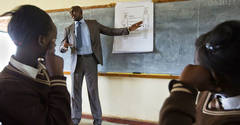Conference lays out roadmap to improve sexuality education in West and Central Africa
A regional conference addressing education issues related to HIV prevention, sexual and reproductive health and gender equality is being held in Dakar, Senegal.
The conference, which aims to raise awareness on comprehensive sexuality education for young people, is organized by UNESCO in partnership with UNAIDS, UNFPA, UNICEF, UN Women and Evidence to Action.
The event, which takes place from 7 to 9 October 2015 in Dakar, brings together representatives of the Ministries of Education and Health from 24 countries, as well as members of civil society, UN agencies and other technical and financial partners.
The conference is designed to mobilize governments on the importance of health education for young people with a specific focus on themes related to their sexual and reproductive health needs including early pregnancy, HIV, and gender-based violence in and out of school.
The conference will also take stock of the current situation in West and Central Africa (WCA), presenting the results of studies on youth needs and evaluations of education responses. WCA has the highest proportion of children and young people in the world (UNFPA 2014; UNICEF, 2014) and it is crucial to ensure that the education and health sectors come together to provide them with access to services they need to live healthy lives and to ensure that issues like early pregnancy, gender-based violence and HIV-related discrimination do not hinder their right to education.
<- Back to: HIV and AIDS

